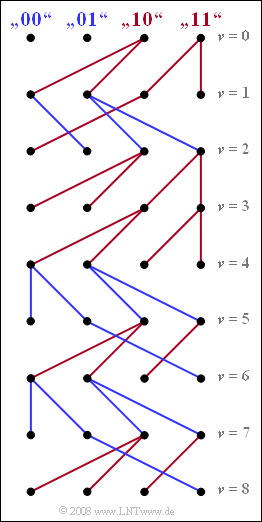Exercise 3.12: Trellis Diagram for Two Precursors
From LNTwww
We assume the basic pulse values g0≠0, g_{\rm –1}\ne 0 and g_{\rm –2}\ne 0:
- This means that the decision on the symbol a_{\rm \nu} is also influenced by the subsequent coefficients a_{\rm \nu +1} and a_{\rm \nu +2}.
- Thus, for each time point \nu, exactly eight metrics \varepsilon_{\rm \nu} have to be determined, from which the minimum accumulated metrics {\it \Gamma}_{\rm \nu}(00), {\it \Gamma}_{\rm \nu}(01), {\it \Gamma}_{\rm \nu}(10) and {\it \Gamma}_{\rm \nu}(11) can be calculated.
- For example, {\it \Gamma}_{\rm \nu}(01) provides information about the symbol a_{\rm \nu} under the assumption that a_{\rm \nu +1} = 0 and a_{\rm \nu +2} = 1 will be.
- Here, the minimum accumulated metric {\it \Gamma}_{\rm \nu}(01) is the smaller value obtained from the comparison of
- \big[{\it \Gamma}_{\nu-1}(00) + \varepsilon_{\nu}(001)\big] \hspace{0.15cm}{\rm and} \hspace{0.15cm}\big[{\it \Gamma}_{\nu-1}(10) + \varepsilon_{\nu}(101)\big].
To calculate the minimum accumulated metric {\it \Gamma}_2(10) in subtasks (1) and (2), assume the following numerical values:
- unipolar amplitude coefficients: a_{\rm \nu} ∈ \{0, 1\},
- basic pulse values g_0 = 0.5, g_{\rm –1} = 0.3, g_{\rm –2} = 0.2,
- applied noisy detection sample: d_2 = 0.2,
- minimum accumulated metric at time \nu = 1:
- {\it \Gamma}_{1}(00) = 0.0,\hspace{0.2cm}{\it \Gamma}_{1}(01) = 0.2, \hspace{0.2cm} {\it \Gamma}_{1}(10) = 0.6,\hspace{0.2cm}{\it \Gamma}_{1}(11) = 1.2 \hspace{0.05cm}.
The graph shows the simplified trellis diagram for time points \nu = 1 to \nu = 8.
- Blue branches come from either {\it \Gamma}_{\rm \nu –1}(00) or {\it \Gamma}_{\rm \nu –1}(01) and denote a hypothetical "0".
- In contrast, all red branches – starting from the {\it \Gamma}_{\rm \nu –1}(10) or {\it \Gamma}_{\rm \nu –1}(11) states – indicate the symbol "1".
Notes:
- The exercise belongs to the chapter "Viterbi Receiver".
- All quantities here are to be understood normalized.
- Also, assume unipolar and equal probability amplitude coefficients: {\rm Pr} (a_\nu = 0) = {\rm Pr} (a_\nu = 1)= 0.5.
Questions
Solution
(1) The first metric is calculated as follows:
- \varepsilon_{2}(010) = [d_0 - 0 \cdot g_0 - 1 \cdot g_{-1}- 0 \cdot g_{-2}]^2= [0.2 -0.3]^2\hspace{0.15cm}\underline {=0.01} \hspace{0.05cm}.
Correspondingly, for the other metrics:
- \varepsilon_{2}(011) \ = \ [0.2 -0.3- 0.2]^2\hspace{0.15cm}\underline {=0.09}\hspace{0.05cm},
- \varepsilon_{2}(110) \ = \ [0.2 -0.5- 0.3]^2\hspace{0.15cm}\underline {=0.36}\hspace{0.05cm},
- \varepsilon_{2}(111) \ = \ [0.2 -0.5- 0.3-0.2]^2\hspace{0.15cm}\underline {=0.64} \hspace{0.05cm}.
(2) The task is to find the minimum value of each of two comparison values:
- {\it \Gamma}_{2}(10) \ = \ {\rm Min}\left[{\it \Gamma}_{1}(01) + \varepsilon_{2}(010), \hspace{0.2cm}{\it \Gamma}_{1}(11) + \varepsilon_{2}(110)\right] = {\rm Min}\left[0.2+ 0.01, 1.2 + 0.36\right]\hspace{0.15cm}\underline {= 0.21} \hspace{0.05cm},
- {\it \Gamma}_{2}(11) \ = \ {\rm Min}\left[{\it \Gamma}_{1}(01) + \varepsilon_{2}(011), \hspace{0.2cm}{\it \Gamma}_{1}(11) + \varepsilon_{2}(111)\right] = {\rm Min}\left[0.2+ 0.09, 1.2 + 0.64\right]\hspace{0.15cm}\underline {= 0.29} \hspace{0.05cm}.
(3) The first and last solutions are correct:
- The sequence "1011010" can be recognized from the continuous path: "red – blue – red – red – blue – red – blue".
- On the other hand, no final statement can be made about the symbol a_8 at time \nu = 8:
- Only under the hypothesis a_9 = 1 and a_{\rm 10} = 1 one would decide for a_8 = 0, under other hypotheses for a_8 = 1.
